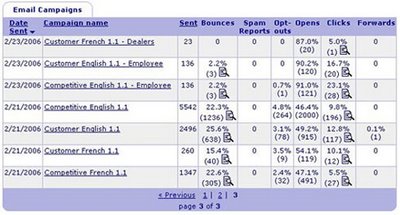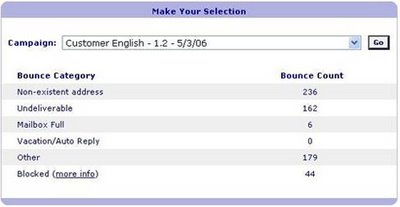Constantcontact.com is a easy to use web based software for your e-mail marketing needs. It manages subscribers (both unsubscribe and new subscription), bounce-back, lists all wrong e-mail addresses, gives me open rate and also click thru rate for individual articles in my e-newsletter.
See below for an example of the summary statistics generated by constantcontact.com:

Below is an example of bounce-back details provided by constantcontact.com for a particular e-mail campaign:

Is constantcontact.com right for you?
Benefits of using Constantcontact.com:
Subscriber lists:Constantcontact.com is a very easy to use tool. I can easily divide my subscribers into different groups to send them different versions of my e-newsletter, based on their interests, customer status or geographics area. When new subscribers want to sign up for my e-newsletter, they will be prompt to subscribe to one of the available groups that fits their interests.
Design template:Constantcontact.com offers many different easy-to-use e-mail marketing template. You can also further customize it to fit your needs. In my case, I have customized a template to abide by my company's branding requirements and to create an unique e-newsletter design.
Pricing:
Pricing of the tool is very reasonable. Be sure to check it out at
www.constantcontact.com. I like the fact that I only have to pay a fixed monthly fee based on my list size. You are entitled for discounts if you prepay for 6 months or a year. You can send as many e-mail campaigns as you want with no limitation/ extra costs. For many other e-mail marketing services, they charge you based on the number of e-mail you sent. Although the cost per email will be cheaper if you are sending out more email, the later is harder for me to plan my annual e-mail marketing budget as the cost is not fixed but based on number of e-mail I sent.
IT resources:Another good thing about using web based service is that you do not need to invest more into your server or IT equipment to accomodate the hardware/bandwidth requirements for sending out huge number of emails at a time. If you purchase an e-mail marketing software and installed it in-house, you might need to subscribe for additional bandwidth for your server, new computer/server and using a specific platform required. Lots of headache there. With a web based service, you do not have to worry about these.
Advanced html editor:Constantcontact.com is so easy to use and you don't need to be a seasoned html programmer to create a professional e-mail campaign. Of course, it will be beneficial to know a little bit of html. You would need to go to the html advanced editor to edit the following info in your e-mail campaign done in constantcontact.com.
1) If you want to change the "Subscribe now/Join us" heading, text and button, you would need to go to the advanced editor to change the codes there. In my case, I need to change it into French, so I need to go into the advanced editor to modify it.
Limitations in using Constantcontact.com:Some text cannot be changed:
1) There are 2 lines that cannot be changed, even in the advanced editor. It is a bit inconvenience for me as those lines are in English and I cannot change them into French in my French e-newsletter. I have contacted constantcontact.com and they have told me those 2 lines are hard coded in the software and cannot be altered.
These 2 lines are:
i) "To no longer receive our emails, click to unsubscribe." This line appears in the beginning of your e-mail.
ii) " This email was sent to
myemail@email.com, by
yourcompany@email.com." This line appears at the end of your email.
Spam control:Some ISPs / IT department in different companies have blacklisted anything sent from a constantcontact.com account. Their users have reported too many spam from the constantcontact domain. Although yours might not be a spam, your client requested to have information sent to them. Since the ISP has bloacked the domain, your email will not be received. If you can, ask your customer to submit a non-generic email address (e.g. do not use info@, sales@). These generic email will sometimes be blocked by the e-mail marketing software itself.
Graphics of your e-mail campaign got altered by web based e-mail host:If your email campaign is targeted to non-business audiences, and the majority of which are using hotmail, gmail, yahoo type of accounts, constantcontact.com might not be an ideal tool to use. I have tried to send e-mail campaign to hotmail and gmail, the layout of my e-newsletter got altered, the graphics are not showing the way it suppose to be.
In my case it is not a big problem as my company is only dealing with business users and most of them do not use a web based e-mail address. However, if yours is a B2C business, you might want to double check if constantcontact.com is an ideal tool for you. Sign up for a free trial, create a test campaign and send to your hotmail/gmail/yahoo (any web based e-mail account) account, you will see if the software will alter your e-mail design layout.




 Below is an example of bounce-back details provided by constantcontact.com for a particular e-mail campaign:
Below is an example of bounce-back details provided by constantcontact.com for a particular e-mail campaign:























